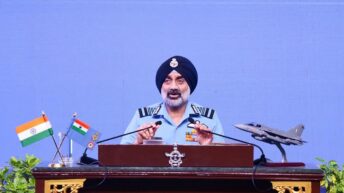
September 29, 2020, marks the fourth anniversary of the unprecedented Surgical Strike carried out by the Indian army against terror launchpads on and along the Line of Control (LOC). Through the strikes at seven launchpads situated in Pakistan-occupied-Jammu & Kashmir (PoJK), a strong message was sent not only to Pakistan but also to the world that India is not afraid to stand up to her adversaries or any kind of threat to her national security. This doctrinal shift in India’s approach has served her well in the aggressions that have followed in the last four years from both sides of her border. In these times of geopolitical changes and tensions at the Ladakh border, it becomes imperative to revisit the Surgical Strike and how it reasserted the values that the new India stands for.
Through the strikes at seven launchpads situated in Pakistan-occupied-Jammu & Kashmir (PoJK), a strong message was sent not only to Pakistan but also to the world that India is not afraid to stand up to her adversaries or any kind of threat to her national security.
Revisiting the Incident
In the wee hours of September 29, 2016, Indian commandos were dropped at the LOC. Within 500 m – 2 km along the LOC, strikes were carried out in Bhimber, Kel, Lipa and Hotspring sectors of PoJK. Seven terror launchpads were destroyed by the Indian forces. On the same day by noon, Lt Gen Ranbir Singh, DGMO and Vikas Swarup, Official Spokesperson, MEA, took the world by surprise when they presented details of the operation. The DGMO also stated that the operation had stopped and that he had conveyed details of its execution along with the concerns of India to the Pakistani DGMO.
Eleven days before the Surgical Strikes, a fidayeen attack was carried out at the Indian army headquarters in Uri. 18 Indian soldiers had lost their lives in this attack and all the 4 terrorists belonging to a Pakistani jihadi group were neutralised. While confrontations between terrorist groups and security forces were not new to the region, the casualties and modus operandi made the Uri attack one of the deadliest terrorist attacks on Indian soil.
Pakistan’s reaction
For decades Islamabad has been breeding jihadi terrorism in its backyard. Pakistan has turned a blind eye to the multiple requests made by countries and international organizations to eliminate terrorism. It was no surprise when Islamabad denied that cross-border strikes have been carried out by the Indian forces on its soil. Instead, the media wing of the Pakistani army, Inter-Services Public Relations, came out with a statement that Indian forces had conducted ceasefire violations in which two Pakistani soldiers had lost their lives and nine were injured. Till date, Pakistan calls it a ‘figment of Indian imagination’. However, rejecting the Pakistani narrative, the international community came forward to applaud the Indian leadership on their boldness and seriousness to fight terrorism.
India’s Strategic Calculus and the ‘Stability-Instability Paradox’
In a nutshell, the ‘stability-instability paradox’ states that if the nuclear deterrence is credible between the states at a strategic level, then more violence is likely between them at the sub-strategic level. In the South Asian context it would mean that in order to avoid a full-blown nuclear exchange, India and Pakistan will be incentivised to adopt sub-strategic operations. In this case, sponsoring and facilitating jihadi terrorism is also a form of sub-strategic operation.
The intricate detailing, planning, execution and aftermath, when analysed in detail send a comprehensive signal that India, being a responsible state that is committed to peace and international law, is not scared of standing up to the Pakistani mayhem and agenda of terror.
An alternative explanation has been that of an ‘instability-instability paradox’. India being a conventionally superior state has multiple military options to deal with Pakistan, before turning towards the nuclear option as the last resort. This fear of nuclear escalation has tied India’s hands. However, Pakistan, being a revisionist state, is incentivised to take advantage of the situation by undertaking limited conventional aggression even at a strategic level, apart from the usual course of resorting to the sub-strategic levels.
The Surgical Strike of 2016 was a solution to both these paradoxes. The intricate detailing, planning, execution and aftermath, when analysed in detail send a comprehensive signal that India, being a responsible state that is committed to peace and international law, is not scared of standing up to the Pakistani mayhem and agenda of terror.
Deciphering the ‘doctrinal shift’
For long there had been an understanding that India, despite its military might, has been soft in responding to Pakistani aggression and terrorism. The Indian objective behind the Surgical Strike was simple – to change the status quo of the so-called ‘soft’ approach. India succeeded in demonstrating that she is not restrained in her choice of retaliatory and preventive military options. However, this ‘unshackling’ was not equivalent to becoming irresponsible or going rogue. The complexities of attacking multiple targets were ironed out in advance. Satellite imagery, drones, intelligence inputs, real-time monitoring, etc. were deployed to ensure that maximum variables are controlled and there are no compromises made on the intended result. The operation was targeted and controlled with no collateral damages, in order to avoid an escalation. As the details suggest, it is the strategic calculus behind the operation which makes it a ‘surgical’ strike and not a ‘border raid’.
The operation was targeted and controlled with no collateral damages, in order to avoid an escalation. As the details suggest, it is the strategic calculus behind the operation which makes it a ‘surgical’ strike and not a ‘border raid’.
Some, however, chose to brand it as ‘political charlatanism’, ‘modified hot pursuit’ or ‘neither new, nor decisive, nor exceptional, not even surgical’. While the modus operandi of the operation was not unique, it is the totality of it which is unique. Operations of such kind are generally subtle and not publicly acknowledged at the government level. In a stark digression, after the operation was over, officials from the Ministry of External Affairs and Defence, together gave an account of the details in a press conference. The Indian intention was clear – to send an unambiguous message to Pakistan that India will not tolerate their tacit agenda of terrorism and to the world that while India is acting on her right of self-defence, she is doing so responsibly and she is also willing to bear the cost.
Conclusion
The 2016 Surgical Strike should not be seen in isolation. It was part of the larger comprehensive diplomatic and military strategy of India to deal with aggressors threatening her national security. Changing times call for new solutions to existing problems or the trap gets deeper. The Surgical Strike was one such response to Pakistan’s nuclear blackmailing due to which India was perceived to be a weak state. In times when geopolitical tensions are rising in South Asia, it is important to remember that the new India will not shy away from exploring the full range of its strategic options, whether diplomatic or military.






Congratulations Somya, 💐
Excellent article written in very clearl manner, very much pleased to read this . Looking forward for upcoming articles.Keep it up.bless you..🇮🇳
Jaihind
Very inspiring heart touching speech less
Excellent work. Particularly highlighting the doctrinal shifts taking place. More importantly, the division between strategic deterrants and tactical priorities is a crucial link in understanding the nature of the evolving statecraft for the region.
Excellent write up with precise words & information.its a depection of crystal clear thought and understanding of subject.may u come out such article in comming days Soumya